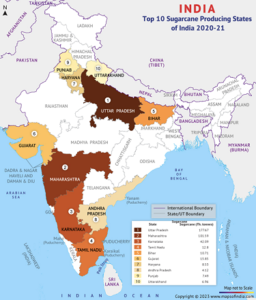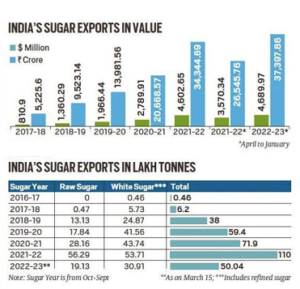India’s excess sugar production is guzzling groundwater.
Relevance:
GS1, GS3, Economy
Introduction:
India became the world’s top sugar producer in 2021-2022, surpassing Brazil with a record of 359 lakh tonnes. However, the extensive use of resources in sugar production is depleting rapidly, leading to a potential crisis in the future. Over-cultivation of sugarcane has caused a sugar surplus and high exports, impacting groundwater negatively. To prevent the risk of agricultural collapse, addressing groundwater overuse in the sugar industry is crucial.
Hike in Sugar production:
- India is the world’s largest consumer of sugar, and thus has to produce enough to meet its huge domestic demand. But the excess production stems from policies and measures that make farmers favor sugarcane cultivation.
- The Central government offers a fair and remunerative price (FRP) scheme, which mandates a minimum price that sugar mills have to pay to sugarcane farmers, ensuring that farmers always get fair profits for their crop. State governments also offer heavy subsidies to incentivize sugarcane cultivation.
- In fact, Brazil, Australia, and Guatemala filed a complaint with the World Trade Organization (WTO) against India for violating international trade rules by offering excessive export subsidies and domestic support to farmers to outcompete other countries in the global sugar market. The WTO ruled against India and India also lost its appeal.
Efforts for addressing the issue:
- To deal with the sugar surplus, the Indian government considered diverting it to the production of ethanol, an organic compound made by fermenting sugarcane molasses or sugar.
- Ethanol is the active ingredient in alcoholic beverages and is also used in the chemicals and cosmetics industries.
- In the transport sector, the use of ethanol-blended petrol (EBP) significantly reduces harmful emissions, such as carbon monoxide and various hydrocarbons, from vehicles.
- The government launched the EBP programme in 2003 to reduce crude oil imports and curtail greenhouse gas emissions from petrol-based vehicles; it has been fairly successful.
- It started with the modest goal of achieving a blending rate of 5%, but the target set for 2025 is 20%.
- The government also reduced the Goods and Services Tax on ethanol from 18% to 5% in 2021.
- In the same year, of the 394 lakh tonnes of total sugar produced, about 350 lakh tonnes were diverted to produce ethanol, while India achieved a blending rate of 10% months ahead of the target.
Excessive sugarcane cultivation impacting groundwater:
- India’s EBP program reduced crude-oil imports, sugar exports, and greenhouse-gas emissions. However, sugarcane’s water-intensive cultivation has taken a toll.
- Sugarcane requires 3,000 mm of rainfall, but top-growing States get 1,000-1,200 mm, relying heavily on groundwater from confined aquifers, a limited resource.
- 100 kg of sugar needs two lakh litres of groundwater for irrigation, raising concerns as these States are already drought-prone and groundwater-stressed, as per a 2022 CGWB report.
The solutions:
- A better and more sustainable way would be to assess and then correct incentives that skew in favor of sugarcane over other crops, leading to a consistent surplus.
- Introducing fair and comprehensive subsidy schemes for a variety of crops can help farmers diversify as well as distribute cultivation evenly, prevent monocultures, and ensure an equitable income.
- The availability of a wider range of profitable and less resource-intensive crops can lower the strain on vital natural resources.
- This must be complemented by environmentally responsible sugarcane cultivation practices that prioritize groundwater, such as drip irrigation, to tackle the issue in the long run.
- In drip irrigation, water is allowed to drip slowly but directly to the roots of sugarcane plants, reducing water consumption by up to 70% relative to the current flood irrigation method.
- This method has already been made mandatory in many parts of India, and the government has also offered subsidies to farmers for setting up the system.
- Next, India needs to invest in overall water-saving and management systems.
Way forward:
- Concerted efforts to adopt cleaner practices such as rainwater harvesting, wastewater treatment, and canal irrigation networks, will help minimise stress on groundwater reservoirs as other water sources become available for irrigation.
- Although the CGWB conducts significant research and generates valuable data, many aspects of groundwater availability and distribution remain poorly understood and/or mapped.
- Investment in groundwater research, therefore, needs to be considered seriously.
- As India continues to become more of a global frontrunner in the agricultural sector, it must put sustainability at the centre.





